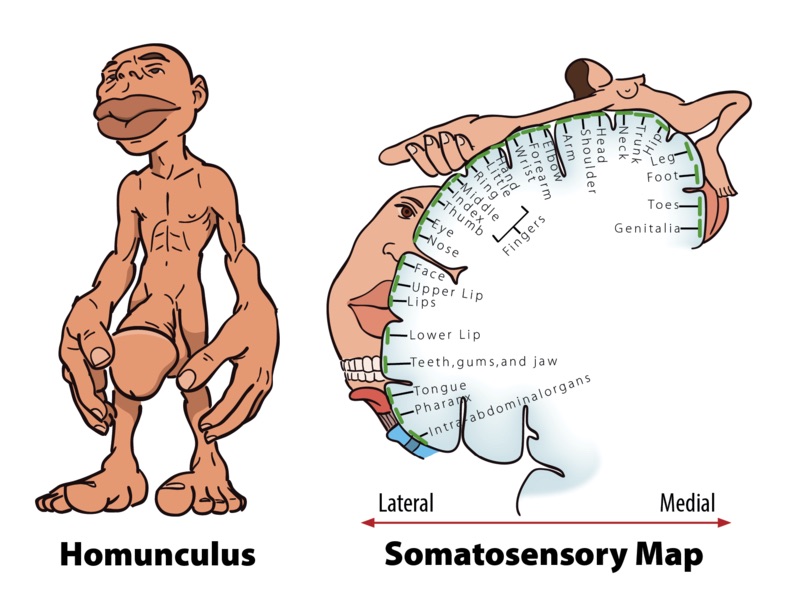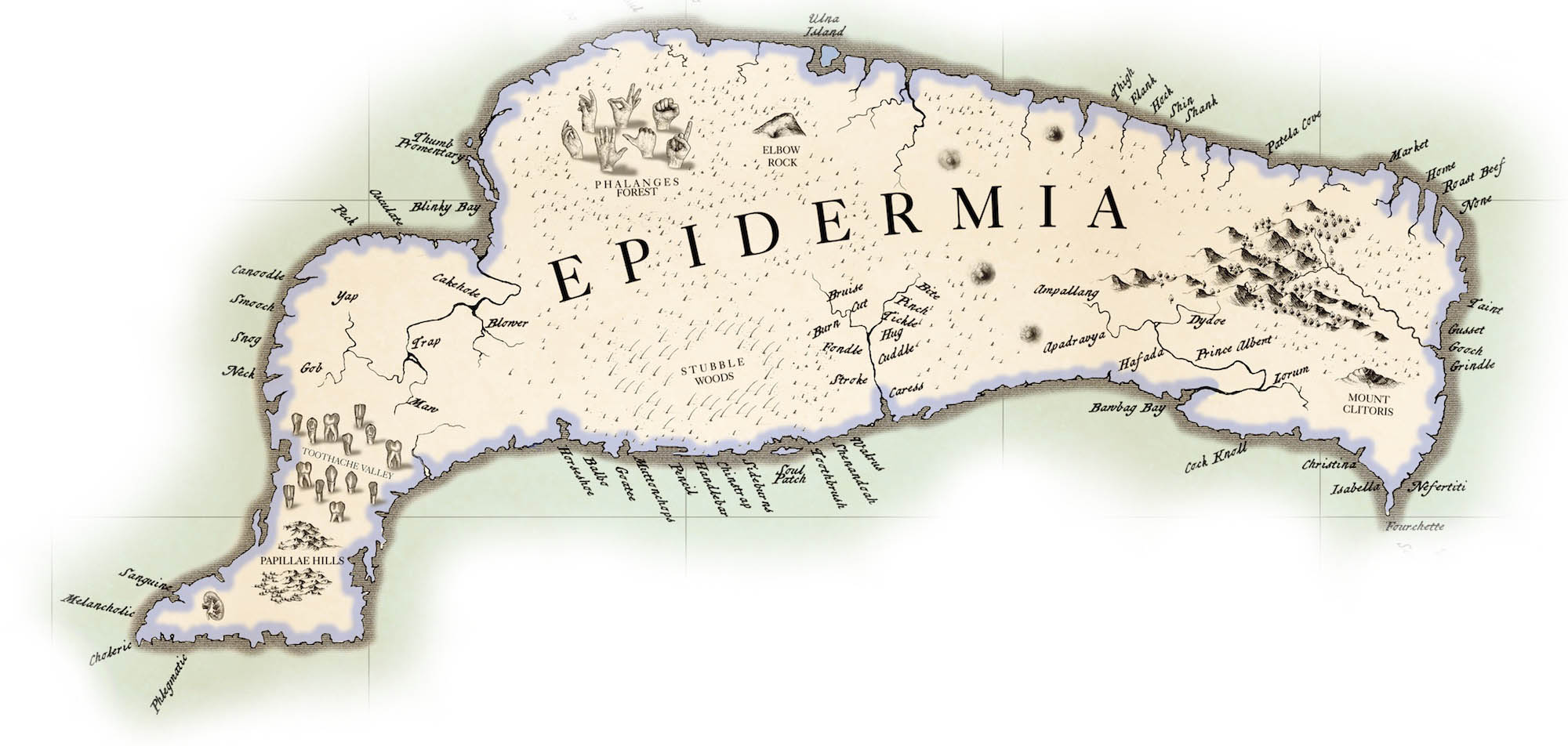Click on the map to learn more
The Four Humours
The ancient Greeks believed the body contained four fluids - blood, yellow bile, black bile and phlegm. Illnesses were ascribed to imbalances in these humours. The Somatosensory Cortex gets signals from the internal organs, as well as the surface of the skin, before the days of invasive surgical techniques, the 'feeling in your guts' was often all a physician had to go on.
Papillae Hills
The surface of the tongue is highly sensitive, and covers a disproportionate area of the Somatosensory Cortex.
Toothache Valley
There's no pain quite like toothache, perhaps because it is relatively unusual and seemingly inaccessible.
Kissing
Kissing has a wide range of connotations between cultures. It is hypothesised that it developed from the act of passing partially chewed food from parent to child.
Slang terms for the mouth
"Shut your cakehole!" - a delightfully British request to stop talking
Stubble Woods
Shaving has been around for a long time; before the advent of razors, hair was sometimes removed using two shells to pull the hair out. Male facial hair styles have been used to display tribal allegiance and in some religions a full beard is considered de rigour.
Touch
The mechanoreceptors of the skin allow us to feel heat and pain, yet we also use them for non-verbal communication.
Male Genital Piercings
Adorning the penis with jewellry, for sensory enhancement or aesthetic display, has a long history.
The Apadravya piercing is mentioned as early as the Kama Sutra.
Female Genital Piercings
The history of female genital piercing is relatively unknown, but evidence suggests it has been around as long as male genital piercing. Vaginal piercings are rare: a 2015 study revealed that while 72% of women have piercings, only 2% of them are on the genitals.
Piggies
A nursery rhyme, often recited whilst playing with the toes:
This little piggy went to Market,
This little piggy stayed home,
This little piggy had Roast Beef,This little piggy had None,
And this little piggy went...
"Wee wee wee" all the way home...
The rhyme first appeared in print in 1728
The Perineum
from Greek περίνεος perineos perinaeon, peri-, around + inein to discharge or defecate.
Mount Clitoris
The genitalia contain thousands of nerve endings, and as such occupies a large area of the Somatosensory cortex.
Phalanges Forest
Human hands with their opposable thumbs are one of our most advantageous evolutionary adaptations. They are also highly sensitive sensory surfaces allowing us to glean tremendous information about the world.
The sensory surface of the body is directly represented, topologically, on this part of the brain.
By experimentation, including direct stimulation of the brain in conscious subjects undergoing brain surgery, the proportion of cortex associated with each part of the skin's surface can be mapped into a sensory homunculus which has been delighting and terrifying students of psychology for years.

The Four Humours
The ancient Greeks believed the body contained four fluids - blood, yellow bile, black bile and phlegm. Illnesses were ascribed to imbalances in these humours. The Somatosensory Cortex gets signals from the internal organs, as well as the surface of the skin, before the days of invasive surgical techniques, the 'feeling in your guts' was often all a physician had to go on.
Papillae Hills
The surface of the tongue is highly sensitive, and covers a disproportionate area of the Somatosensory Cortex.
Toothache Valley
There's no pain quite like toothache, perhaps because it is relatively unusual and seemingly inaccessible.
Kissing
Kissing has a wide range of connotations between cultures. It is hypothesised that it developed from the act of passing partially chewed food from parent to child.
Slang terms for the mouth
"Shut your cakehole!" - a delightfully British request to stop talking
Stubble Woods
Shaving has been around for a long time; before the advent of razors, hair was sometimes removed using two shells to pull the hair out. Male facial hair styles have been used to display tribal allegiance and in some religions a full beard is considered de rigour.
Touch
The mechanoreceptors of the skin allow us to feel heat and pain, yet we also use them for non-verbal communication.
Male Genital Piercings
Adorning the penis with jewellry, for sensory enhancement or aesthetic display, has a long history.
The Apadravya piercing is mentioned as early as the Kama Sutra.
Female Genital Piercings
The history of female genital piercing is relatively unknown, but evidence suggests it has been around as long as male genital piercing. Vaginal piercings are rare: a 2015 study revealed that while 72% of women have piercings, only 2% of them are on the genitals.
Piggies
A nursery rhyme, often recited whilst playing with the toes:
This little piggy went to Market,
This little piggy stayed home,
This little piggy had Roast Beef,This little piggy had None,
And this little piggy went...
"Wee wee wee" all the way home...
The rhyme first appeared in print in 1728
The Perineum
from Greek περίνεος perineos perinaeon, peri-, around + inein to discharge or defecate.
Mount Clitoris
The genitalia contain thousands of nerve endings, and as such occupies a large area of the Somatosensory cortex.
Phalanges Forest
Human hands with their opposable thumbs are one of our most advantageous evolutionary adaptations. They are also highly sensitive sensory surfaces allowing us to glean tremendous information about the world.
